USE OF ELECTRICAL STIMULATION IN PHYSIOTHERAPY
Table of Contents
FARADIC CURRENT
faradic type current is a short duration interrupted direct current. They have a pulse duration of 0.1 to 1 ms and a frequency of 50 to 100 Hz. The point here to note is faradic current is direct current but with a short duration interruption of 0.1 to 1 microsecond.
the term faradism was originally used to signify the type of current produced by a faradic coil, which is a type of induction coil. the current provided by the first faradic coils was an unevenly alternating current, each cycle consisting of two unequal phases, the first of low intensity and long duration, the second of high intensity and short duration. the frequency was approximately 50 hz and the duration of second phase, which was the effective one, about 1 ms.
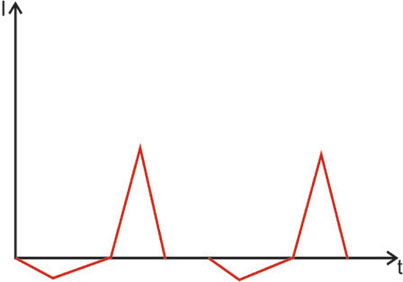
faradic coils hsve now been superseded by electronic stimulator. these supply current which produce the same physiological effects as the original faradic current, although often differing considerably from them in wave form. the features essential for the production of these physiological effects are that impulses with a duration of between 0.1 and 1 ms are repeated 50-100 times per second. the electronic stimulator for the production of the faradic-type current works on the same principles as that for the interrupted d.c.
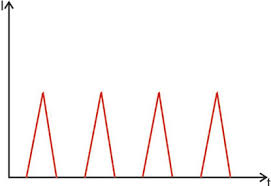
MODIFIED FARADIC CURRENT
faradic type currents are always surged for treatment purpose to produce a near-normal tetanic-like contration and relaxation of muscle. it is desirable that the duration of surges and the intervals between them should be regulated by separate controls in order that the most satisfactory muscle contraction and rest periods can be obtained for each patient.
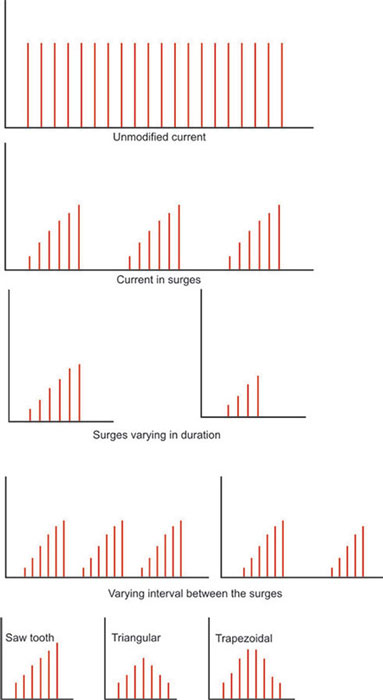
The following figures differentiates between a alternating current (AC), direct current (DC), interrupted direct current.
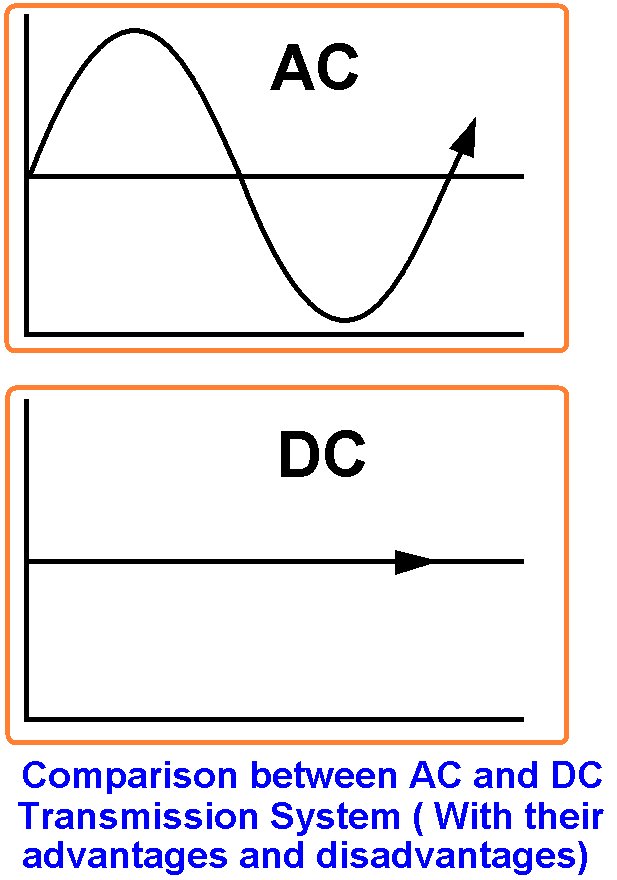
GALVANIC VS FARADIC CURRENT
- Indications of faradic type current
- Muscle re-education.
- Training new muscle action.
- Muscle strengthening.
- Galvanic current
Galvanic type current is a long duration interrupted direct current. if faradic is a short duration interrupted D.C, then galvanic is a long duration interrupted D.C.An interrupted direct current also called long duration current having more than 1 ms up to 300 ms or 600 ms. But the commonly used duration 100 ms duration requires a frequency of 30 pulses/ min. If the duration increases the frequency may reduce. The interval between the impulses should never of shorter duration than the impulses themselves
MECHANISM OF GALVANIC CURRENT
DEFINATION
- the cathode is where species are reduced.
- the anode is where species are oxidized.
Anode or Cathode
Rechargeable cells offer a helpful way to see why the cathode in a galvanic cell becomes the anode in an electrolytic cell. Rechargeable cells work in both galvanic and electrolytic modes – galvanic when they are powering devices; electrolytic when they are being recharged.
1) SPONTANEOUS (i.e. ΔG IS NEGATIVE) REDOX REACTION
at the electrodes produce a voltage. The voltage can drive electrons through electric devices, such as a lightbulb.
species spontaneously transfer electrons to the electrode on the right; species are oxidized, so this is the anode. The electrons transferred to the anode flow from it through the lightbulb to reduce species
2) NON-SPONTANEOUS REDOX REACTION
are driven by an external voltage. The processes here are the galvanic cell’s in reverse.
The current from the power source pushes electrons on to the electrode on the right of the diagram, where they cause a reduction of species – hence this electrode is the cathode.
In electrolytic cells, the cathode is negatively charged. Electrons are pushed on to the cathode by the external power source.
TYPE OF ELECTRODE
1) Metal Plate Electrodes – early version, limited sizes, required wet sponge conduction medium, difficult to secure in place
2) Carbon – Impregnated Rubber Electrodes – degrade over time and become non-uniform with “hot spots”, many shapes and sizes, rinse and dry after each use and replaced every 12 months to ensure conductivity.
3) Self-Adhering or Single use Electrodes – flexible conductors, convenient application, no strapping or taping to keep in place, resealable bag for multiple uses, often high impedance, possibility of cross-contamination, used most frequently these days. Single use electrodes MAY NOT be shared between patients.
Electrode Size and Current Density
- Current density is the concentration of current under an electrodes.
- surface area is inversely proportional to current flow. (Larger electrode = current is less dense as it is distributed over a larger area; the smaller the electrode, the more intense the same current becomes over a smaller area.
- Keep the electrode in proportion with size of body area being treated. If the electrode is too large for the area, there could be unwanted carryover to other surrounding structures; if too small, the current is too dense and may not be tolerated to elicit the desired response.
- Completing the Circuit – an electrical stimulation treatment must include a full circuit. To complete the circuit, there must be:
- A source of energy creating an electrical potential difference
- A conductive pathway – including electrodes, leads, and a conductive surface with good contact
- Cleaning the patient’s skin with alcohol to remove oil and dirt before electrode application
- Clipping excess body hair under electrodes
- Minimize warming the treatment area of the body prior to stimulation so there is minimal increased resistance
Electrode Configuration
- Monopolar – always two poles: cathode (-) is active and produces cell depolarization. Produces a net charge
2.Bipolar – two electrodes in a single circuit; each electrode alternates between positive and negative; electrodes are of equal size; no net charge is produced
3.Patient will feel excitatory response under both electrodes, eliciting motor response or electrode placed over motor point, other electrode over muscle belly and may be larger
4. Quadripolar – four electrodes in two circuits that operate independently, yet interact
Interferential, large area, pain management, sensory stimulation of larger fiber
Note: electrical stimulation units will call the circuit
INDICATION OF GALVANIC CURRENT
Contraction of denervated muscle. For example, use of galvanic current in foot drop
Stimulation of small muscles which easily gets tired. Like muscles of .
This is mainly used to influence the pain threshold.
Produce hyperemia
Iontophoresis and analgesia with the stimulation simultaneous application of certain medicines will facilitate better penetration of medicine.
Galvanic vs Faradic current
Here is brief difference
- Duration of interruption Long duration interrupted D.C of 100 ms Short duration Interrupted D.C of 0.1 to 1 ms
- Frequency of current 30 per minute 50 to 100 Hz
- Denervated muscle contraction Can produce contraction of denervated muscle
- Can NOT produce contraction of denervated muscle
Commonly - used to stimulate small muscles (like facial muscles) Commonly
- used to stimulate large muscles (ex: quadriceps)
Galvanic current:
Galvanic currents are used chiefly for facial muscles.
A galvanic current uses mild electric currents that consist of positive and negative ions to fuel the local muscles.
The outcome of a galvanic current is upholding the muscle physiology.
Faradic current:
The faradic current is the current produced by the reduction or oxidation of some chemical substance at an electrode.
The total faradic current is the algebraic sum of all the fardaic currents flowing through an indicator electrode or occupied electrode.
HOW TO PLACE ELECTRODES?
Electrodes never placed directly on the skin – they need to have hydrophilic cloth folded over them. Most frequently we use sponges moistened with water. Prepared electrodes usually fixated with elastic bandages or sandbags.
Physiological effect
–The intensity and duration of impulses in galvanic current adequate so that it can cause a sluggish worm like a contraction.
When current applied it produces sensory stimulation resulting in the feeling stabbing or burning sensation.
It increases blood circulation causing erythema (redness) of the skin.
Stimulation of motor nerve with such current produces contraction of the muscle supplied by that nerve.
Galvanic current affects neural endings responsible for the transfer of pain so that the pain diminished or removed completely. Cathodes enhance stimulativeness and conduciveness of the nerves, while anodes diminish them.
Vasodilation (expansion of blood vessels) happens under the influence of the galvanic current, causing hyperemia, excessive accumulation of blood in a part of the body. The skin under the electrode becomes warmer, redder, and moister, in a period of up to 30 minutes.
Therapeutic effects
confusion over the therapeutic use of electrical stimulation for denervated muscles for the last many years. The purpose of such current to maintain the muscles in as healthy state as possible to prevent the complication by electrically artificial contraction. Skeletal muscles have a greater power of regeneration. When the muscles are denervated the following changes will occur.
- Loss of voluntary contraction and reflex activities
- Atrophy: Resulting in fibrosis
- Fibrillization: Spontaneous contraction
- If some of the motor units (motor end plate + motor nerve + muscle fibers) are intact galvanic current is the choice of treatment.
- Interrupted direct current is still recommended for the treatment of Axonotmesis and Neurotmesis nerve repair is to be taken
WHEN TO APPLY GALVANIC CURRENT?
- rheumatic diseases, except in their active or acute phase
- paresis and paralysis – galvanic current is here used as the introduction for electrostimulation (galvanic current diminished skin resistance through hyperemia, so we can achieve a strong muscle contraction with little stimulation
- blood vessel diseases and circulation disorders
Contraindications
Cardiac pacemakers and Arrhythmias
Hemorrhagic condition
Thrombosis and thrombophlebitis (inflammation of the wall of a vein)
Early tendon transfer and repair
Pregnancy: On pelvic, low back, and abdomen
Unconscious patient (COMA)
Recent radiotherapy
Child with mental disturbance
Malignancy
Infected wound and skin lesion
Treatment Goal
1) Muscle (motor) Stimulation
One channel per muscle with both electrodes on the same muscle, two leads if it Is a larger muscle or if the device has more than one head
2) Sensory Stimulation
One or two channels depending on the size of the area; use as many electrodes as possible to achieve the desired sensory stimulation
One channel only if two electrodes fit in the treatment area
3) tissue repair
One channel: active electrode in the treatment area and the dispersive is placed proximally to target area >12-18″ away
Techniques of treatment with faradic-type currents
1)preparation of apparatus
the operator should test the arppratus by attaching leads and electrodes to the terminals, holding the two electrodes in a moistened hand, inserting the core if a smart-bristow coil is being used, and turning up the current until a mild prickling sensation is experienced and a muscle contraction produced. describe to the patient the sensation you feel and make sure the patient can see the muscle contraction produced.
the active electrode may be a disc-electrode or a small lint/sponge pad with flat plate-electrode. the latter is preferable for large muscles like quqdriceps and glutei, as it is easier to mould to the surface, so obtaining good contact. a flat plate-electrode and lint/sponge pad are used for the indifferent electrode, to complete the circuit. the pads and lint covering the disc-electrode are soaked in warm 1 per cent saline. tap-water can be used, but the addition of salt reduce the resistance of the wetting solution, 1 per cent saline having a rather lower resistance than the tissue fluids.
2) preparation of the patient
clothing is removed from the area to be treated and the patient is supported comfortably in a good light. it is important that the patient is warm, otherwise the muscles do not respond well to the stimulation. it is usually easiest to obtain muscles contraction in response to electrical stimulation and muscles are in shortened position.
stimulation of motor point
the indifferent electrode is applied and secured in a suitable area. the active electrode may be a disc electrode, which is held between the index and middle fingers, or a small pad which is held in the palm of the hand. it is placed over the motor point of the muscles to be stimulated. ensures that the whole of operator’s hand should be in contact with the patient tissue. then the intensity of the current is gradually increased until a good muscle contraction is obtained at minimum point of each surge, then the surging is continued to produce alternate contraction and relaxation of the muscle.
motor point are frequently at the junction of the upper and middle one-thirds of fleshy belly of the muscle, e.g. the extensors hallucis longues in the lower one third of the lower leg.
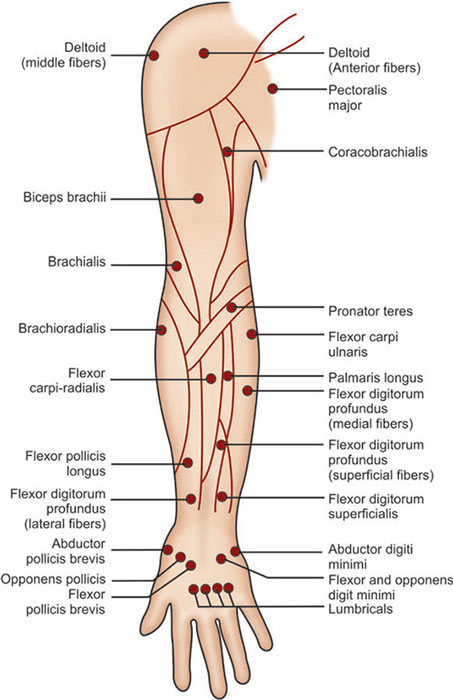
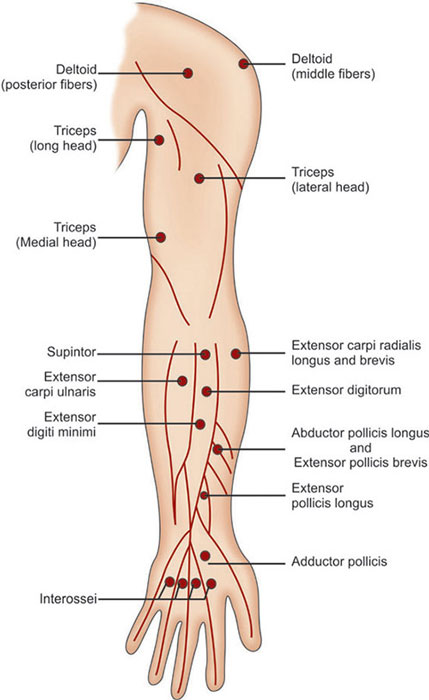
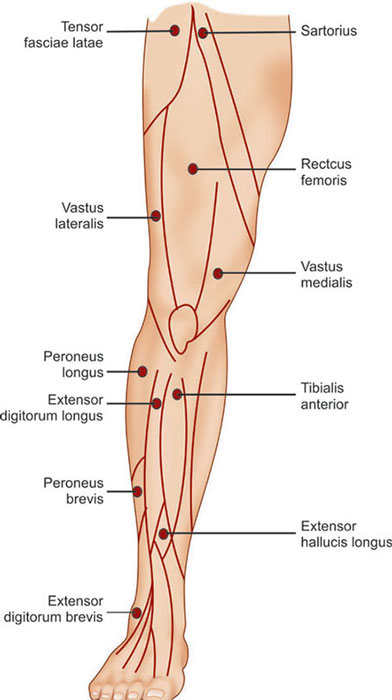
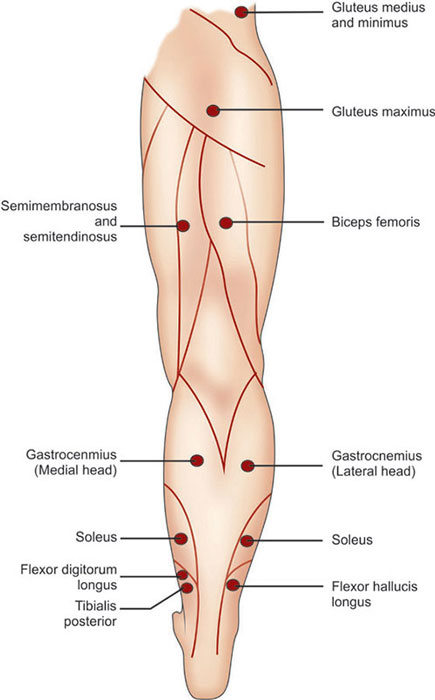
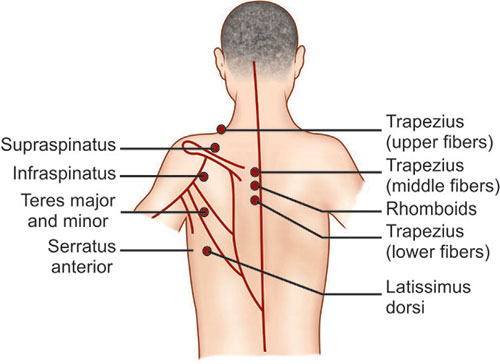
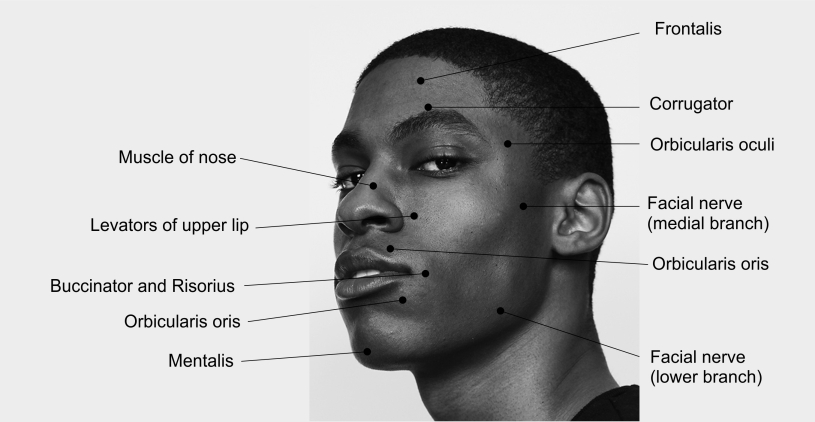
interrupted direct current
interruption is the most usual modification of direct current, the flow of current commencing and ceasing at
regular intervalse. the rise and fall of intensity may be sudden or gradual.
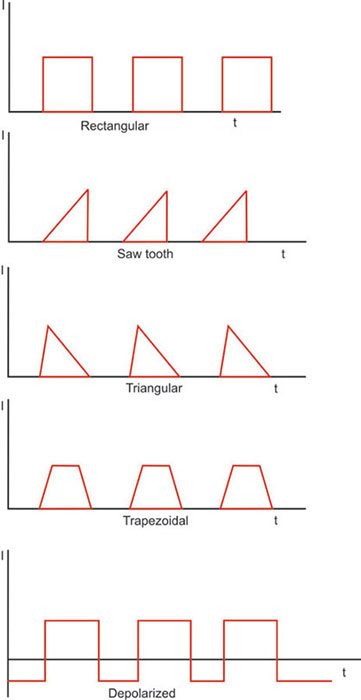
the impulses in which the current rises gradually are often termed selective because a contraction of denervated muscle can often be produced with an intensity of current that is insufficient to stimulate the motor nerves because accomodation occurs.
the duration and frequency of the impulses can be adjusted, a duration of 100ms being commonly used. an impulse of 100 ms duration requires a frequency of about 30 per minute, but if the duration is increased the frequency must be reduced. the interval between the impulse should never be of shorter duration than the impulses themseleves and is usually apprecibly longer.
some equipment allows for a low-intensity reserved current between the impulses giving so-called depolarized impulses. the passage of a direct current through an electrolyte causes chemical changes to take place at the electrodes. now that constant d.c is rarely used the chances
of chemical burn are much reduced.
production of interrupted d.c is usually accomplished in modern appratus by circuits which employ transistors and timing devices. current is always applied to the patient via a potentiometer as this allows the intensity of current to be turned up from zero physiological effects of interrupted d.c
Physiological effect of interrupted direct current
provided that the intensity of current and duration of impulses are adequate, a contraction of denervated muscle can be initiated. the contraction are sluggish, the contraction and relaxation being slower than when the motor nerve is stimulated. when interrupted d.c is applied to the body there is stimulation of sensory nerves. stimulation of motor nerve with interrupted d.c produce contraction of the muscles supplied.Indication for use of interrupted d.c
the main value of interrupted d.c lies in its ability to produce contractions of denervated muscles. when a muscle is deprived of its nerve supply, changes in its structure and properties tend to occur. there is marked wasting of the muscle fibres and, if degeneration is of long-standing, they tend to become fibrosed and to lose their properties of irritability, contractability, extensibility and elasticity. electrical stimulation of the muscle fibres may slow down these changes, although no one has ever shown in a controlled experiment that this is so, and it is doubtful whether it is possible to restore the muscle bulk or properties by these means once they have been lost.
Electrical stimulation strong enough to produce contraction. The duration of treatment should not be excessive as it will lead to muscle fatigue. Comfortable pulse duration should be used.
re-educate muscle
gain the range
improve strength
improve circulation
facilitate muscles contraction
Techniques of treatment with interrupted d.c
1) methods of application
when applying modified d.c the aim of treatment is direct stimulation of the muscle fibres, therefore the treatment must be arranged so that the current passes through all the fibres, of the muscle. there are various methods of achieving this. one pad may be fixed over the origin of the muscle group, and each muscle stimulated in turn with the active electrode. the active electrode, the active electrode is a disc or small pad which is either held over the lower end of the fleshy belly of the muscle to be stimulated or stroked slowly down it ( libile techanique.)
both these methods have the advantage that the current can be regulated to produce the optimum contraction of each muscle, and that each muscle is rested while other muscles of the group are being stimulated. they suffer from the disadvantage that if there are many muscle to be stimulated it is not practicable to produce a large number of contractions of each.alternative two disc electrode may be used. one placed over each ends of the muscle to be stimulated. this method is usuful for the stimulation of deeply placed muscle which are difficult to isolate, such as the extensor pollicis longus,
2) preparation of equipment
the appratus is tested and the other equipment prepared.make sure that the covering of the disc electrode and the disc electrode and the pads consist of at least eight layers of lint. this is because it is possible to get a chamical burn with long-duration pulses if the treatment is given at same spot for long periods of time.
3) preparation of the patient
the skin is prepared by washing and protecting abrasions as for other electrical treatments. it is often an advantage to soak the part in warm water before the treatment to lower the resistance of the skin and to warm the muscles, although if there is loss of sensation care must be taken that the water is not too hot. part shouled be supported so that muscles in relax and shortened position alternatively the current may be applied with the muscle in a partly lengthened position.this should only be done if contraction produced are sufficiently strong to cause shortening of the muscle and so joint movement.
4) application of interrupted d.c
muscle contraction are often obtained most easily if the active electrode is connected to the anode, but this is not always the case. each patient should be tested to determine wheater the anode or the cathode produces the better response, and the more effective pole used for the active electrode. increased the intencity until a good contraction is obtained.

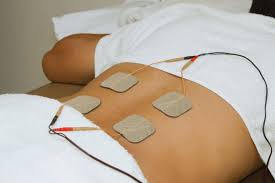
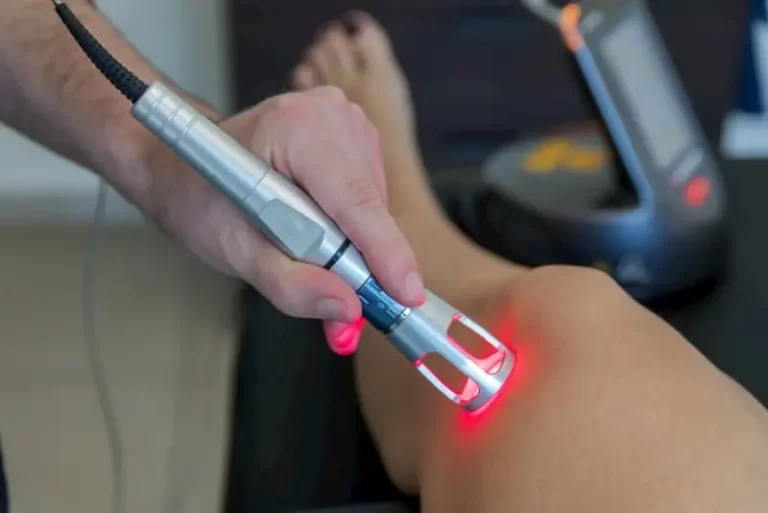

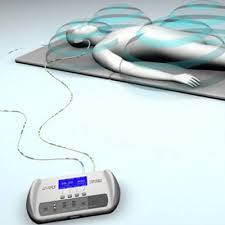
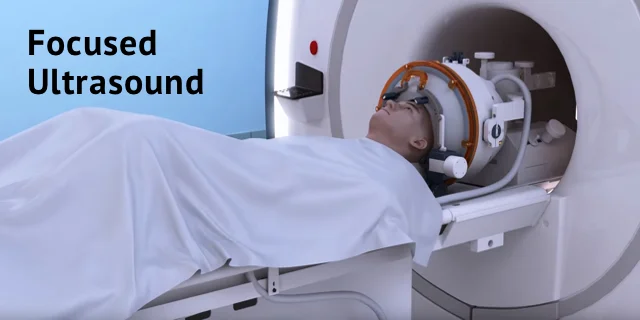
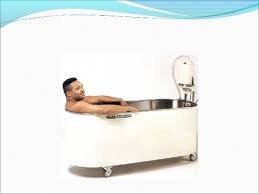
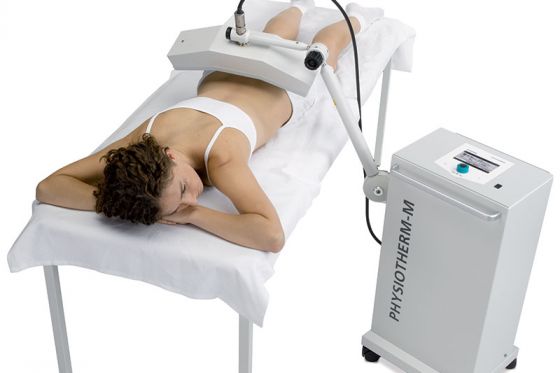
12 Comments